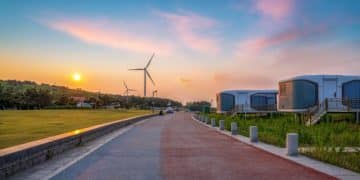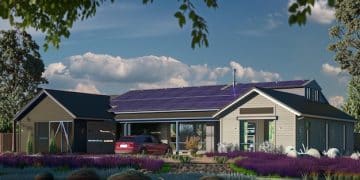How Will the Updated US Energy Policy Impact Your 2025 Energy Bills?

The updated US energy policy enacted in 2024 is projected to significantly influence household energy bills in 2025 by promoting a shift to renewable sources, increasing grid resilience, and potentially offering consumer incentives, though regional variations and market dynamics will play a crucial role in the precise impact on individual expenses.
As 2025 approaches, many Americans are pondering a critical question: How Will the Updated US Energy Policy Impact Your 2025 Energy Bills? The legislative landscape surrounding energy is constantly evolving, with recent federal initiatives poised to reshape how we power our homes and businesses. Understanding these changes is not merely an academic exercise; it’s essential for household budgeting and future planning.
understanding the policy shift in 2024
The year 2024 marked a significant pivot in US energy policy, building upon foundational legislative acts and introducing new directives aimed at decarbonization, energy security, and grid modernization. This policy shift wasn’t a singular event but rather a culmination of sustained efforts to address climate change while ensuring a stable and affordable energy supply. Its multifaceted approach intends to touch various segments of the energy ecosystem, from generation and transmission to consumption patterns. The primary goal behind these comprehensive updates is a long-term transition towards cleaner energy sources, enhanced infrastructure resilience, and ultimately, a more sustainable energy future for the nation.
The federal government’s renewed commitment to these goals is evident in the allocation of significant funding towards research, development, and deployment of cutting-edge energy technologies. This includes investments in advanced battery storage, carbon capture technologies, and next-generation nuclear power, alongside a continued push for established renewables like solar and wind. These policy movements reflect a growing consensus that a diversified energy portfolio is crucial for national security and economic stability. By fostering innovation and encouraging private sector investment, policymakers hope to accelerate the transition away from fossil fuels, reducing greenhouse gas emissions and mitigating the impacts of climate change.
One of the core tenets of the 2024 policy updates is a renewed focus on energy efficiency across all sectors. This encompasses new building codes, appliance standards, and funding for efficiency upgrades in homes and businesses. The rationale is clear: the cheapest energy is the energy not used. By reducing overall demand, the strain on the grid lessens, and the costs associated with power generation and transmission are potentially mitigated. This consumer-centric approach to energy policy aims to empower individuals and communities to take active roles in managing their energy consumption, offering both financial incentives and educational resources.
driving forces and key legislative actions
Several critical factors underpinned the 2024 policy shift, including escalating climate concerns, volatile global energy markets, and technological advancements in renewable energy. The legislative actions taken were designed to address these interconnected challenges head-on. Key pieces of legislation reinforced commitments to emissions reductions and sustainable development. These measures often include a combination of tax credits, grants, and regulatory frameworks intended to guide the industry toward cleaner practices and greater efficiency.
- The push for significant federal investment in renewable energy infrastructure. This aims to expand the capacity of solar farms, wind parks, and hydropower facilities across the nation, diversifying the energy mix and reducing reliance on traditional fossil fuels.
- New incentives for energy-efficient technologies and practices for both residential and commercial sectors. These incentives encourage consumers and businesses to adopt more sustainable habits, from installing smart thermostats to upgrading to more efficient appliances.
- Enhanced regulatory frameworks for carbon emissions and pollution control. These measures set stricter standards for industries, compelling them to reduce their environmental footprint and invest in cleaner production methods.
The policy changes also reflect an understanding that energy security is paramount. Diversifying sources and strengthening the grid are seen as means to protect against supply disruptions, whether from geopolitical events or extreme weather. The overarching narrative is one of energy independence through innovation and domestic resource utilization. Public-private partnerships are a crucial component, leveraging the vast resources of the private sector to achieve national energy goals.
impact on electricity generation and supply
The updated US energy policy is set to profoundly reshape the landscape of electricity generation and supply, with a clear trajectory toward a more diversified and cleaner energy mix. Central to this transformation is the increased adoption of renewable energy sources. Federal incentives and regulatory directives are accelerating the deployment of solar, wind, and geothermal power, marking a significant departure from historical reliance on fossil fuels. This shift is not merely about environmental benefits; it’s also about building a more resilient and decentralized grid, less susceptible to supply chain disruptions and price volatility.
New investments in grid infrastructure are also a critical component. The existing grid, in many areas, is aging and not fully equipped to handle the influx of intermittent renewable energy or the demands of a rapidly electrifying economy. Policy measures aim to modernize transmission lines, enhance energy storage capabilities, and integrate smart grid technologies. These upgrades are vital to ensuring reliability and efficiency, enabling power to flow seamlessly from diverse generation sources to consumers. The goal is to create a dynamic and intelligent grid that can adapt to changing supply and demand patterns, incorporating two-way energy flows from distributed energy resources like rooftop solar.
Furthermore, the policy encourages innovation in energy storage solutions, which are crucial for the widespread integration of renewables. Battery technology, pumped-hydro storage, and even emerging solutions like green hydrogen are receiving significant attention and funding. Effective storage can smooth out the variability of renewable generation, ensuring a consistent power supply even when the sun isn’t shining or the wind isn’t blowing. This holistic approach to generation and supply transformation underlies the federal government’s vision for a robust, clean, and affordable energy future.
the rise of renewable sources
Renewable energy is at the forefront of the new policy, with significant federal backing for its expansion. This includes substantial tax credits, grants, and loan programs for solar, wind, hydro, and geothermal projects. The aim is to make these energy sources more competitive with traditional fossil fuels, driving down their installed costs and accelerating their market penetration.
- Increased federal tax credits for residential and commercial solar installations. This makes it more financially attractive for homeowners and businesses to generate their own power, potentially leading to lower electricity bills and greater energy independence.
- Expansion of offshore wind energy development, leveraging vast coastal resources. This initiative taps into new energy frontiers, providing a consistent power source that can complement land-based wind farms and traditional generation.
- Investment in geothermal energy and advanced hydropower, diversifying the renewable portfolio. These less conventional renewables offer baseload power and additional stability to the grid, contributing to a more reliable energy supply.
The growth of renewables also has important implications for localized energy production. Community solar projects, for instance, allow multiple households to benefit from solar power without needing individual rooftop installations. This democratization of energy production could lead to more stable and predictable energy costs for consumers, as less power is sourced from volatile wholesale markets. The emphasis on renewable energy also brings co-benefits, such as improved air quality and reduced public health costs, adding to the overall societal value proposition.
modernizing the grid and infrastructure
A resilient and efficient electricity grid is paramount to the success of the new energy policy. Significant investments are earmarked for upgrading aging infrastructure, enhancing cybersecurity, and integrating smart grid technologies. These advancements are essential for handling the complexities of a diversified energy mix, including intermittent renewable sources and distributed generation.
- Federal funding for smart grid technologies, enabling real-time monitoring and management of electricity flow. This enhances the grid’s ability to respond to demand fluctuations, optimize energy distribution, and prevent costly outages, making the system more efficient and reliable.
- Development of advanced energy storage solutions, such as large-scale batteries and pumped-hydro storage. These technologies store excess renewable energy for use during peak demand or when renewable generation is low, ensuring a consistent and uninterrupted power supply.
- Strengthening transmission lines and interconnections to improve energy transfer between regions. A robust transmission network reduces bottlenecks, allows for more efficient distribution of power, and enhances the overall resilience of the electricity grid.
These infrastructure improvements are not just about making the grid “smarter” but also “harder” against physical and cyber threats. Cybersecurity measures are being bolstered to protect critical energy infrastructure from malicious attacks, ensuring continuous operation. Furthermore, the integration of distributed energy resources like rooftop solar and electric vehicles will transform consumers from passive energy users into active participants in the grid. This evolution will require sophisticated management systems, but it also opens doors for new economic opportunities and greater control over energy consumption.
direct effects on residential energy bills
The updated US energy policy is designed with an eye on the consumer, aiming to make energy more affordable and predictable in the long run, yet the direct effects on residential energy bills in 2025 will vary. One of the most anticipated impacts is the potential for reduced electricity rates in regions heavily transitioning to renewables. As renewable sources like solar and wind have lower operating costs compared to fossil fuel plants, their increased integration into the grid can put downward pressure on wholesale electricity prices. This reduction can then translate into lower charges on your monthly bill, especially in areas with high renewable adoption and favorable legislative frameworks for passing those savings to consumers.
However, it’s also important to acknowledge that initial investments in new infrastructure, grid modernization, and renewable deployment might lead to temporary surcharges or adjustments in fixed charges on utility bills. These costs are typically amortized over many years, meaning their impact on any single bill tends to be incremental rather than drastic. Utility companies often seek regulatory approval for such investments, and the prudence of these expenditures is usually scrutinized to ensure consumer protection. The long-term benefits – enhanced reliability, reduced carbon emissions, and potentially stable energy prices – are considered to outweigh these initial costs.
Beyond direct bill charges, new policy incentives are emerging that can offer substantial savings for homeowners. These include expanded tax credits and rebates for energy-efficient home improvements, such as installing insulation, upgrading to smart thermostats, or purchasing energy-efficient appliances. Furthermore, programs promoting rooftop solar installation and electric vehicle charging infrastructure can significantly offset grid reliance and fossil fuel consumption, leading to reduced overall energy expenditures. For many households, these incentives represent one of the most tangible ways the new policy will directly impact their pockets.
potential cost savings through efficiency and renewables
The policy actively promotes energy efficiency as a primary pathway to consumer savings. Tax credits and rebate programs for home energy audits, insulation improvements, and energy-efficient appliance upgrades are being expanded. These measures aim to reduce overall energy consumption, directly translating into lower bills.
- Expanded federal tax credits for energy-efficient windows, doors, and insulation upgrades. These incentives make it more affordable for homeowners to invest in improvements that reduce heat loss in winter and heat gain in summer, leading to significant heating and cooling savings.
- Rebates for purchasing ENERGY STAR certified appliances, from refrigerators to washing machines. Replacing older, less efficient appliances can dramatically cut electricity consumption, providing immediate and ongoing savings on utility bills.
- Incentives for installing smart thermostats and home energy management systems. These technologies allow for optimized energy usage, adapting to occupancy and weather patterns, helping homeowners save money by preventing unnecessary heating or cooling.
Beyond efficiency, the widespread adoption of rooftop solar is poised to offer significant long-term savings. Net metering policies, which credit homeowners for excess electricity generated and sent back to the grid, will continue to play a crucial role. This can effectively reduce or even eliminate a household’s electricity bill, turning a liability into an asset. The combined effect of efficiency measures and distributed renewable generation empowers consumers to take greater control over their energy costs, insulating them from market fluctuations.
factors influencing regional variations in bill impact
While the updated energy policy is federal, its impact on energy bills will vary significantly by region due to a confluence of factors, including existing energy infrastructure, state-specific regulations, and climate. States already heavily invested in renewable energy infrastructure and with supportive legislative frameworks may see faster and more pronounced benefits from the federal policies. Their grids might be better prepared to integrate new renewable capacity, leading to quicker cost reductions. Conversely, regions heavily reliant on traditional fossil fuels may experience a slower transition or face initial costs associated with decommissioning older plants and building new infrastructure.
- State-level renewable energy mandates and incentives. Some states have ambitious renewable portfolio standards (RPS) that accelerate the transition to clean energy, potentially leading to lower costs as renewable sources come online and replace more expensive conventional power.
- Existing grid infrastructure and its capacity for modernization. Regions with aging or underdeveloped grids may require substantial investment to integrate new technologies, which could temporarily reflect in higher charges on consumer bills before long-term savings materialize.
- Local fuel mix and prevailing energy prices. The specific mix of energy sources (e.g., coal, natural gas, hydro, nuclear, solar, wind) in a region’s power generation significantly influences prices; a region heavily reliant on volatile natural gas may see different impacts than one with diverse sources.
Climate also plays a role. Regions with abundant solar resources will naturally benefit more from solar incentives, while windy states might see greater gains from wind energy deployment. Regulatory environments, including the structure of utility markets (regulated vs. deregulated), will also dictate how quickly and directly federal policy changes translate into consumer bill impacts. Some states have “restructured” markets where consumers can choose their electricity supplier, potentially offering more competitive rates. Other states have vertically integrated utilities with rates set by state commissions, which might slow down the pass-through of federal policy benefits.
broader economic and societal benefits
Beyond individual household bills, the updated US energy policy is crafted to deliver substantial broader economic and societal benefits. On an economic front, the transition to a cleaner energy economy is anticipated to be a significant job creator. Investment in renewable energy projects, grid modernization, and energy efficiency programs will require a vast workforce, spanning manufacturing, construction, installation, and maintenance. This focus on domestic energy production can also reduce the nation’s reliance on imported fuels, strengthening energy independence and safeguarding against global market volatility. New industries and technologies will also emerge, fostering innovation and creating new avenues for economic growth and competition in areas like battery storage and advanced materials.
From a societal perspective, the benefits extend to improved public health and environmental quality. Reducing reliance on fossil fuels directly correlates with decreased air and water pollution, which, in turn, can lead to lower rates of respiratory illnesses, cardiovascular diseases, and other health issues. This translates into tangible savings in healthcare costs and improved quality of life for communities, particularly those historically disproportionately affected by industrial pollution. Furthermore, mitigating climate change impacts, such as extreme weather events and rising sea levels, offers long-term societal resilience and protection for critical infrastructure and agricultural systems.
The policy also emphasizes energy justice, aiming to ensure that the benefits of the energy transition are shared equitably across all demographic groups and geographic regions. This includes targeted programs to assist low-income households with energy efficiency upgrades and to promote clean energy development in underserved communities. By prioritizing affordability and accessibility, the policy seeks to prevent a situation where the benefits of clean energy accrue only to a privileged few. Ultimately, the comprehensive nature of the policy aims to build a more sustainable, equitable, and prosperous future for all Americans, transcending immediate financial impacts to address deeper systemic challenges.
job creation and economic growth
The energy transition is a powerful engine for job creation. Investments in renewable energy manufacturing, installation, and maintenance are poised to generate thousands of new jobs across the country. This economic activity reverberates through various sectors, stimulating growth and innovation. The demand for skilled labor in areas like solar panel installation, wind turbine technicians, and smart grid engineers is projected to rise significantly, offering new career paths and opportunities for workforce development.
- Growth in manufacturing jobs for renewable energy components. As the demand for solar panels, wind turbine parts, and battery storage units increases, so does the need for domestic manufacturing, creating stable, well-paying jobs.
- Surge in construction and installation jobs for new energy infrastructure. Building new solar farms, wind parks, transmission lines, and energy storage facilities requires a substantial workforce, providing employment opportunities throughout the country.
- New opportunities in energy efficiency retrofitting and smart technology deployment. As homes and businesses upgrade to more efficient systems, there will be increased demand for technicians specializing in insulation, HVAC, and smart home technology installation and maintenance.
Moreover, reduced dependence on imported energy sources can foster greater energy independence, shielding the US economy from global price shocks and geopolitical instabilities. This shift strengthens national security while keeping more energy dollars within the domestic economy. The innovation spurred by the new energy policies also creates a fertile ground for new businesses and startups, further propelling economic growth and maintaining the US’s competitive edge in the global clean energy market.
environmental and public health improvements
A driving force behind the updated policy is the imperative to address climate change and its environmental consequences. By accelerating the shift from fossil fuels to cleaner energy sources, the policy aims to significantly reduce greenhouse gas emissions and other air pollutants. The benefits extend beyond climate change mitigation to tangible improvements in public health, especially for communities located near traditional power plants. Cleaner air means a reduction in respiratory illnesses, cardiovascular diseases, and other health complications linked to pollution, leading to substantial savings in healthcare costs.
- Reduction in air pollutants like sulfur dioxide, nitrogen oxides, and particulate matter. These reductions directly translate into fewer instances of asthma attacks, bronchitis, and other respiratory ailments, particularly benefiting children and the elderly.
- Mitigation of greenhouse gas emissions contributing to climate change. Lowering carbon footprints helps in combating extreme weather events, sea level rise, and other long-term environmental challenges, preserving ecosystems and natural resources.
- Conservation of water resources used in traditional power generation. Many conventional power plants require large quantities of water for cooling; transitioning to renewables often reduces this water demand, benefiting water-stressed regions.
Furthermore, decreased reliance on mining and drilling for fossil fuels can lead to less land disruption and habitat destruction, preserving biodiversity and natural landscapes. These environmental improvements also have aesthetic and recreational benefits, enhancing the quality of life for communities. The long-term societal value of a healthier population and a more vibrant natural environment far outweighs the initial investments required to transition to a cleaner energy system. This represents a proactive approach to protecting both planetary and human well-being for generations to come.
challenges and considerations for 2025
While the updated US energy policy promises significant long-term benefits, its implementation by 2025 will undoubtedly face an array of challenges and critical considerations. One primary concern is grid stability and reliability during the transition. Integrating a higher percentage of intermittent renewable sources like solar and wind requires robust energy storage solutions and advanced grid management systems to prevent disruptions. Ensuring that the lights stay on, especially during peak demand or extreme weather events, necessitates careful planning and massive investment in infrastructure upgrades, which may not be fully realized by 2025. Without sufficient storage and smart grid technologies, an over-reliance on renewables could potentially lead to power fluctuations, affecting both consumers and industries.
Another notable challenge involves the financial implications for traditional energy sectors and communities reliant on fossil fuel industries. The transition away from coal, oil, and natural gas will inevitably lead to job losses and economic shifts in these regions, necessitating comprehensive workforce retraining programs and economic diversification strategies. The pace of this transition must be managed sensitively to avoid creating new pockets of economic distress, even as new jobs emerge in the green energy sector. Equity and justice considerations are paramount to ensure that no community is left behind in this national energy transformation.
Finally, consumer adaptation and behavioral changes pose a significant hurdle. While incentives for energy efficiency and rooftop solar are available, widespread adoption relies on consumer awareness, education, and willingness to invest in these changes. Overcoming inertia and demonstrating the tangible benefits of participation will be crucial for achieving the policy’s full potential. The success of the policy in 2025 and beyond hinges on effectively addressing these intertwined technical, economic, and social challenges.
grid reliability and infrastructure limitations
The reliability of the US electrical grid is a paramount concern during this energy transition. Integrating a higher percentage of intermittent renewables into an aging infrastructure presents significant technical challenges. Without adequate energy storage and advanced transmission capabilities, fluctuations in renewable output could impact grid stability, potentially leading to increased blackouts or price spikes. The existing infrastructure often lacks the necessary interconnections and flexibility to efficiently distribute power from new renewable hubs to demand centers, requiring substantial and timely upgrades.
The intermittency of solar and wind power means that when the sun isn’t shining or the wind isn’t blowing, backup power sources or stored energy must be available. While battery storage technology is advancing rapidly, massive deployment is still needed to provide grid-scale support. Furthermore, the permitting and construction of new transmission lines are often complex and time-consuming processes, which can delay the integration of new renewable generation into the grid. These limitations necessitate strategic planning and substantial capital investment to ensure that the grid can reliably handle the evolving energy mix without compromising service quality.
policy implementation and market response
The effectiveness of the updated energy policy in 2025 will heavily depend on the efficiency of its implementation and the responsiveness of energy markets. Bureaucratic hurdles, inter-agency coordination, and the pace of regulatory approvals can significantly impact the speed at which new projects come online and incentives reach consumers. Delays in funding disbursement or complex application processes could slow down the adoption of new technologies and infrastructure developments.
Moreover, market response plays a critical role. While federal incentives aim to stimulate investment in renewables and efficiency, private sector engagement is essential. Investment decisions by utility companies, renewable energy developers, and manufacturers will be influenced by perceived risks, the stability of policy frameworks, and the long-term profitability of clean energy projects. Unforeseen market dynamics, such as fluctuations in commodity prices or global supply chain issues for critical components, could also affect the cost and feasibility of implementing policy goals. Effective communication and collaboration between government, industry, and consumers will be key to navigating these challenges and ensuring a smooth transition.
| Key Area | Potential 2025 Impact on Bills |
|---|---|
| ☀️ Renewable Energy | Potential for lower per-unit electricity costs due to increased supply and reduced operational expenses of renewables. |
| 🏠 Energy Efficiency Incentives | Direct savings through tax credits and rebates for home upgrades, reducing overall energy consumption. |
| ⚡ Grid Modernization | Possible temporary bill adjustments from infrastructure investments; long-term gains in reliability and efficiency. |
| 🌍 Regional Differences | Impact varies by state policies, existing energy mix, and infrastructure development pace. |

frequently asked questions About US Energy Policy
Not necessarily. While increased renewables can put downward pressure on wholesale prices, initial infrastructure investments might lead to temporary surcharges. Regional energy mixes, local utility decisions, and state regulations will significantly influence whether specific rates decrease, increase, or remain stable for individual households in 2025.
The updated policy expands tax credits and rebates for energy-efficient home improvements like better insulation, smart thermostats, and ENERGY STAR appliances. Incentives also exist for installing rooftop solar panels and electric vehicle charging infrastructure, which can help offset reliance on grid electricity and fossil fuels, leading to savings.
Grid modernization aims to make the energy supply more reliable and efficient. While direct daily impact might be subtle, it can mean fewer outages, more stable voltage, and potentially participation in demand-response programs, which could offer rebates for reducing energy use during peak times, leading to savings.
Yes, significant regional variations are expected. States with proactive renewable policies and established clean energy infrastructure may see benefits faster. Conversely, regions heavily reliant on traditional energy sources might experience initial transition costs. Local climate, existing energy mix, and state regulatory environments will play a crucial role in the specific bill impact.
The long-term outlook generally anticipates more stable and potentially lower energy bills due to increased renewable integration, reduced fossil fuel price volatility, and widespread energy efficiency. As the grid becomes more resilient and decarbonized, consumers are expected to benefit from healthier environments and more predictable energy costs over time.

conclusion
The updated US energy policy represents a pivotal moment in the nation’s energy trajectory, signaling a profound commitment to decarbonization, grid resilience, and energy independence. While the precise impact on individual residential energy bills in 2025 will be influenced by a complex interplay of federal incentives, regional market dynamics, and consumer choices, the overarching direction is clear. The policy aims to foster a more sustainable, stable, and ultimately more affordable energy future for American households. By embracing cleaner energy sources, investing in cutting-edge infrastructure, and empowering consumers through efficiency programs, the nation is laying the groundwork for long-term benefits that extend far beyond the immediate financial ledger, touching upon public health, economic growth, and environmental stewardship.





